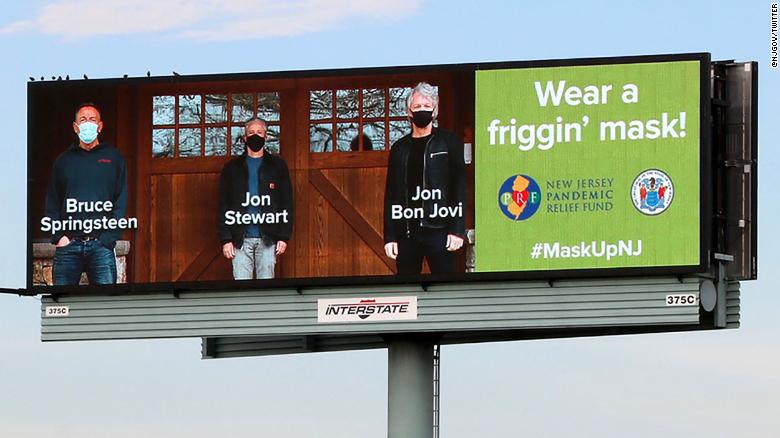By Pam Hersh
As I emerged on Black Friday from the Princeton CVS on Nassau Street to a horde of unmasked kids who refused to move out of the way to let me pass, I turned red with anger, assumed the status of a crazy little lady, and hollered: “Wear a friggin’ mask.”
Thank you to New Jersey’s First Lady Tammy Murphy. She inspired me to act – by sending me a sign – literally. The New Jersey Department of Health and the New Jersey Pandemic Relief Fund, founded by First Lady Tammy Murphy, created a billboard with three of my favorite New Jerseyans – Bruce Springsteen, Bon Jovi and Jon Stewart. Wearing masks, the three pop culture icons are pictured standing next to each other and saying “Wear A Friggin’ Mask.” Reportedly, there are 30 of these billboards scattered throughout the state, even though I have only seen it on Twitter. I would have added a footnote: ‘Wear your friggin’ mask over your mouth and NOSE.’
I contemplated installing a lawn sign reproducing the billboard, but banned that thought from my psyche, when I realized it would mean that Princeton would accumulate yet another lawn sign. The unchecked invasion of lawn signs is certainly less deadly than COVID, but possibly very harmful to everyone’s health in the future.
It is truly a quirky quality of humans that in an era of massive electronic and virtual communication, the Fred Flintstone of communications strategies – tactile signs on billboards, bulletin boards, bus shelters, and lawns are favorite vehicles for communication. Unlike the paper notices on bulletin boards and bus shelters which can be safely recycled, the lawn signs have a life of their own – a non recyclable life of their own. Ninety percent of campaign signs are made from corrugated cardboard coated in plastic, making the campaign signs the zombies of the sign world. If you throw out a plastic campaign sign, it will end up in either a landfill and take a very long time to biodegrade or in a waste incinerator, which releases toxic emissions and greenhouse gases when burning plastic. Landfills also produce greenhouse gases, mostly methane and carbon dioxide, which contribute to climate change by trapping heat in the atmosphere.
Lawn signs like weeds took over Princeton’s lawns during this recent heated election, not only because of the Biden/Trump contest, but also because of the school board race in which it seemed as though everyone except for Pam Hersh wanted to be a School Board member. Add these election signs to all the signs promoting social justice, celebrating our first responders, and advertising home renovation contractors, and Princeton residents experienced a lawn-sign blizzard. Maybe, I thought, people figured that plastic signs were effective at keeping the virus away. In fact, they not only fail to thwart the virus, they also raise my blood pressure. The only sign of the season that I did not want to destroy was Tammy Murphy’s sign hoisted high above the ground and easily repurposed when the mask campaign is concluded.
In an effort to reduce my blood pressure, I called Sustainable Princeton to find out what people should do with their plastic lawn signs – no matter what the message.
Talking to Jenny Ludmer, who is the community outreach manager for Sustainable Princeton, I learned of some clever repurposing for the lawn signs of 2020. The signs with timeless messages of social justice (Black Lives Matter, Hate Has No Home Here, etc.), democracy (Vote), and gratitude to first responders, who deserve to be thanked 24/7, should can stay on one’s lawn forever and need no recycling. The political ones, however, present a challenge. Sustainable Princeton recycles the metal holders for the signs, but not the signs themselves.
Jenny and I batted around a few ideas pertaining to sign reuse. The first thing to do is consider whether the candidates may run for office again. Keep those Trump signs, since he has said he will run again in 2024. And who knows about Biden. But if one is unwilling to hold onto a sign for sentimental or political reasons, then hold onto it for artistic and practical reasons.
People have repurposed the signs into museum-worthy collages, funky lamp shades, and stools strong enough to support the weight of an adult. Others have used the signs as construction material for planters, kids’ swings, chicken coops and small sheds.
It seems hard to imagine that scientists and engineers, who responded so miraculously with innovative solutions to the challenges of COVID, are unable to find a way to replace unrecyclable signs with recyclable ones. Probably the best thing one can do is lobby for signs that are recyclable. I am all in favor of old-fashioned communication vehicles – but if elected officials are banning plastic bags (yay, yay, yay) then we need to ban the signs promoting the elected officials who banned plastic bags.
For Sustainable Princeton’s extensive recycling programs, visit
www.Sustainableprinceton.org

